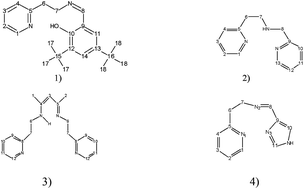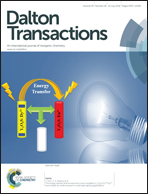Structural studies of copper(ii) complexes with 2-(2-aminoethyl)pyridine derived Schiff bases and application as precursors of thin organic–inorganic layers†
Abstract
Cu(II) complexes with Schiff bases derived from 2-pyridin-2-ylethanamine were obtained and characterized by UV-Vis, fluorescence, and IR spectra. The X-ray crystal structures determined for [Cu(II)(epy(di-t-Buba))Cl] × 0.042H2O and [Cu(II)(epy(di-t-Buba))O2CCH3] revealed tetrahedral distortion of the Cu(II) coordination sphere in the solid phase. For both molecules the Cu(II) ions were found in tetragonal environments, as was confirmed by the values of EPR g-matrix diagonal components. The thermal properties of the complexes and the gas phase composition were studied by TG/IR techniques. Thin layers of the studied copper(II) complexes were deposited on Si(111) by a spin coating method and characterized by scanning electron microscopy (SEM/EDS), atomic force microscopy (AFM) and fluorescence spectra. For copper(II) layers the most intensive fluorescence band from intra-ligand transition was observed between 498 and 588 nm. The layers’ fluorescence intensity was related to the rotation speed and deposition time.


 Please wait while we load your content...
Please wait while we load your content...